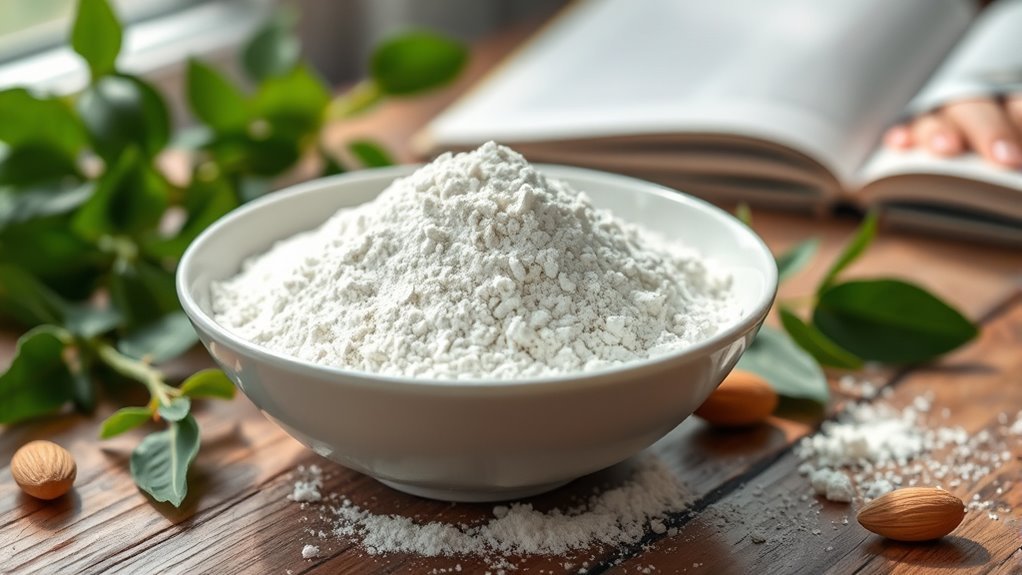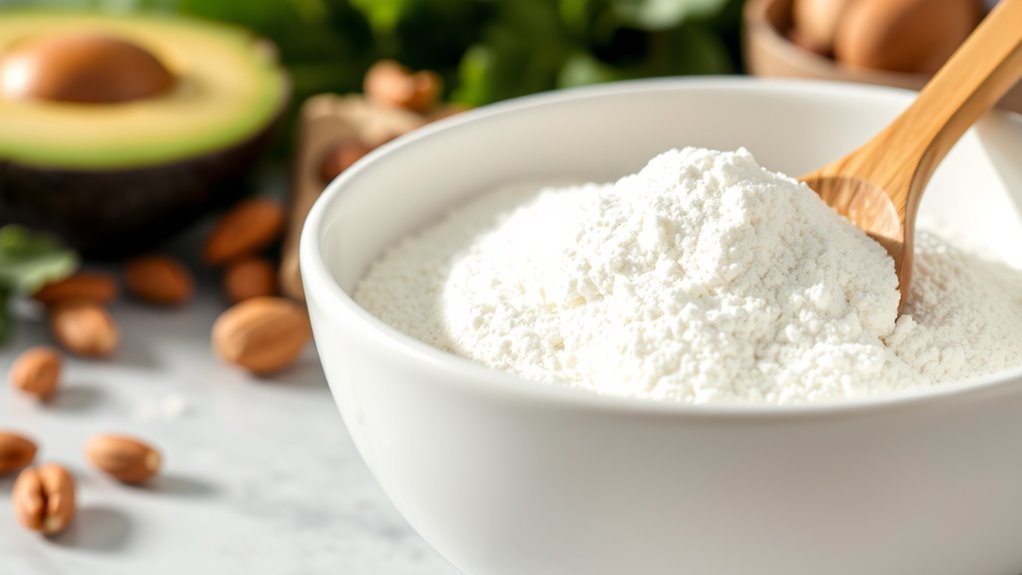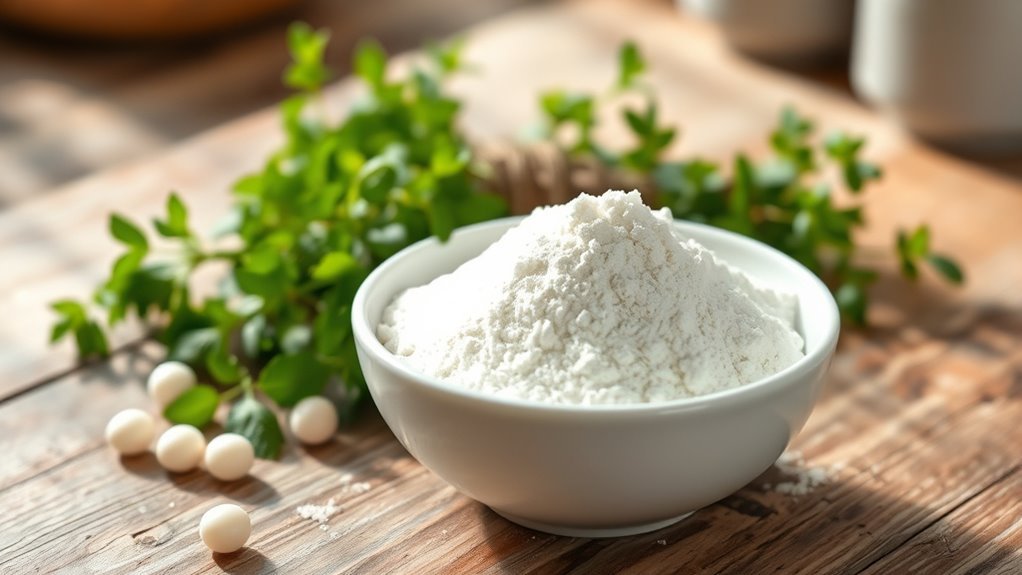Tapioca flour isn’t keto-friendly due to its high carbohydrate content, with about 86 grams of carbs per 100 grams. This can disrupt ketosis by raising blood sugar levels. Though it’s gluten-free and easy to digest, its minimal fiber and protein content make it less ideal for low-carb diets. If you’re looking for alternatives that align better with keto goals, you’re in the right place. There’s more to explore about how to incorporate or substitute this ingredient in your meals.
Understanding Tapioca Flour: What It Is and How It’s Made

Tapioca flour, often a staple in gluten-free cooking, is derived from the cassava root, a tuber native to South America. The process of tapioca production involves peeling the cassava, soaking it, and then grating it to extract the starch. This starch is then dried, resulting in the fine, white flour you see today. You’ll find tapioca flour used in various recipes, from thickening sauces to creating chewy baked goods like tapioca pudding and gluten-free bread. It’s versatile and provides a unique texture that many enjoy. Understanding these flour uses can help you explore alternative cooking methods, especially if you’re looking for gluten-free options or experimenting with different dietary needs.
Nutritional Profile of Tapioca Flour

When considering tapioca flour, it’s important to look at its carbohydrate content, as it’s primarily made up of starches. This flour can offer some nutritional benefits, like being gluten-free and easy to digest, making it a popular choice for those with dietary restrictions. Understanding its nutritional profile can help you decide how it fits into your keto lifestyle.
Carbohydrate Content Overview
With about 88 grams of carbohydrates per 100 grams, tapioca flour stands out as a high-carb ingredient, making it less suitable for a strict ketogenic diet. Originating from the cassava root, tapioca is primarily composed of starch, which contributes to its carbohydrate density. If you’re looking for flour substitutes that align with keto principles, you might consider almond flour or coconut flour, both of which are lower in carbs and higher in fiber. While tapioca can add unique texture to recipes, its high carbohydrate content means that moderation is key. If you’re committed to maintaining ketosis, you’ll want to carefully assess how tapioca flour fits into your overall carb intake and dietary goals.
Nutritional Benefits Explained
Though often considered a high-carb ingredient, tapioca flour does offer some nutritional benefits worth noting. Its primary nutritional value lies in its high starch content, which can provide a quick source of energy. Additionally, tapioca flour is gluten-free, making it a suitable option for those with gluten sensitivities or celiac disease. It contains small amounts of essential minerals like calcium and iron, contributing to overall health benefits. While it lacks significant protein and fiber, when combined with other ingredients, it can enhance the nutritional profile of your meals. If you’re looking for versatility in your cooking, tapioca flour can help you achieve that, allowing for a variety of textures and flavors in your dishes.
Carbohydrates in Tapioca Flour: A Closer Look

Tapioca flour, derived from the cassava root, is often a topic of interest for those traversing a low-carb or ketogenic diet. Understanding its carbohydrate content is vital, especially taking into account its tapioca origins and various flour applications.
Here’s a closer look at the carbohydrate profile:
| Component | Amount (per 100g) |
|---|---|
| Total Carbohydrates | 86.4g |
| Dietary Fiber | 0.9g |
| Sugars | 0.3g |
| Net Carbs | 85.5g |
As you can see, tapioca flour is mainly carbohydrate-rich, making it less favorable for a strict keto approach. If you’re exploring alternatives, it’s wise to reflect on how it fits into your overall carb limit.
The Role of Carbs in a Keto Diet
While some may believe that all carbohydrates are detrimental on a ketogenic diet, it’s important to understand that carbs play a nuanced role in this low-carb lifestyle. Not all carb sources are created equal; certain vegetables and low-sugar fruits can provide essential nutrients while fitting into your macro goals. Depending on your diet variations, you might find that incorporating small amounts of carbs can help maintain energy levels and support overall health. For instance, some people choose to cycle carbs or use targeted approaches that allow for greater flexibility. Ultimately, understanding how different carb sources affect your body can empower you to make informed choices, allowing you to enjoy the freedom of a satisfying and balanced ketogenic journey. Additionally, limiting carbs is crucial for success, as it shifts the body from burning glucose to fat.
How Tapioca Flour Affects Ketosis
When considering tapioca flour in your keto diet, it’s crucial to analyze its carbohydrate content. With a relatively high carb count, tapioca flour can greatly impact your ketosis levels, potentially hindering your ability to maintain a state of fat-burning. Understanding this relationship can help you make informed choices about incorporating it into your meals.
Carbohydrate Content Analysis
In the domain of ketogenic diets, understanding the carbohydrate content of various ingredients is vital, and tapioca flour is no exception. Its high carbohydrate content can greatly impact your carb intake, thereby affecting your ketosis. Here’s a simple breakdown:
| Nutrient | Amount per 100g |
|---|---|
| Total Carbohydrates | 86g |
| Net Carbohydrates | 86g |
| Fiber | 0g |
| Protein | 0g |
When considering keto alternatives, tapioca flour’s carbohydrate absorption might not align with your dietary goals. It’s important to monitor your total carb consumption closely if you decide to use it, as exceeding your limits could hinder your progress. Balancing your meals with lower-carb options is key to maintaining ketosis.
Impact on Ketosis Levels
Understanding how tapioca flour affects your ketosis levels is vital, especially if you’re adhering to a strict ketogenic diet. This flour is primarily made up of carbohydrates, which can considerably impact your ketosis effects. When you consume tapioca flour, it can raise your blood sugar levels, potentially kicking you out of ketosis. For those seeking to maintain a state of fat-burning, even small amounts can be counterproductive. While it offers a gluten-free alternative for certain recipes, it’s important to use it sparingly and be mindful of your overall carb intake. Balancing your meals and focusing on low-carb alternatives will help you stay in ketosis without sacrificing your freedom to enjoy diverse foods.
Possible Health Benefits of Tapioca Flour
Tapioca flour, a gluten-free alternative derived from cassava, offers several potential health benefits that might appeal to those on a keto diet. One of the key tapioca benefits is its high carbohydrate content, providing quick energy without gluten’s negative effects. It’s low in allergens, making it suitable for those with sensitivities. Additionally, tapioca is rich in resistant starch, which may support gut health by acting as a prebiotic. This can enhance digestion and promote a healthy microbiome. Moreover, its mineral content, including calcium and iron, contributes to overall health advantages. While it is crucial to consume tapioca in moderation, incorporating it mindfully into your keto lifestyle can provide these benefits while maintaining your dietary goals.
Alternatives to Tapioca Flour for Keto Dieters
While tapioca flour can offer some benefits, those following a keto diet may seek alternatives that align better with their low-carb goals. Here are some options you might consider:
| Flour Type | Carbs per 100g | Key Benefits |
|---|---|---|
| Coconut Flour | 21g | High in fiber, low in net carbs |
| Almond Flour | 10g | Rich in healthy fats and protein |
| Flaxseed Meal | 29g | Packed with omega-3s and fiber |
| Konjac Flour | 1g | Extremely low in carbs, great for thickening |
Other options include chia seeds and sunflower seed flour, both of which can provide unique textures and flavors. Additionally, incorporating flaxseed’s nutritional profile can help you stay within your carb limits while still enjoying your favorite recipes.
Using Tapioca Flour in Keto Recipes
If you’re considering using tapioca flour in your keto recipes, it’s crucial to understand its role and how it compares to alternative flours. While tapioca flour is high in carbohydrates, it can still be utilized in moderation for specific recipes. Exploring various options and incorporating tapioca flour thoughtfully can lead to delicious results without greatly impacting your carb intake.
Alternative Flour Options
When looking for alternative flour options in keto recipes, it’s essential to evaluate how tapioca flour can fit into your meal plan. While tapioca flour is often used for its binding properties, it’s important to take into account other low-carb alternatives. Almond flour benefits your keto diet by providing healthy fats and protein, making it a popular choice for baking. Coconut flour uses include thickening sauces and creating pancakes, and it’s also high in fiber, which can help with digestion. Both almond and coconut flour can give you the freedom to create delicious meals without compromising your dietary goals. Exploring these options can help you maintain variety while sticking to your keto lifestyle. Additionally, incorporating healthy fats into your baking can enhance flavors and support overall health on the keto journey.
Recipes With Tapioca Flour
Although tapioca flour is higher in carbs compared to other keto-friendly flours, it can still be incorporated into your recipes in moderation to achieve desirable textures and flavors. For instance, you can whip up delicious tapioca flour pancakes that are soft and fluffy, perfect for a weekend brunch. Just mix tapioca flour with eggs, almond milk, and a sugar substitute for a tasty treat.
You can also experiment with tapioca flour bread, which can deliver a chewy texture that many find appealing. Combining it with low-carb ingredients like almond flour or coconut flour lets you enjoy a satisfying loaf without going off track. Remember, moderation is key; balance is essential for maintaining a keto lifestyle.
Moderation: Can You Fit Tapioca Flour Into Your Keto Lifestyle?
While tapioca flour is often considered a high-carb ingredient, you might wonder if it can still find a place in your keto lifestyle. The key lies in moderation strategies and portion control. By being mindful of how much you use, you can enjoy the texture and flavor tapioca flour offers without derailing your keto goals.
Here’s a quick guide to help you balance tapioca flour within your diet:
| Serving Size (g) | Net Carbs |
|---|---|
| 10 | 8 |
| 20 | 16 |
| 30 | 24 |
| 40 | 32 |
| 50 | 40 |
Consider using small amounts for thickening or as a base in recipes. Remember, it’s all about finding what works for you!
Final Thoughts on Tapioca Flour and Keto Diets
As you navigate your keto journey, it’s important to contemplate how tapioca flour fits into your overall dietary choices. While it’s high in carbs and generally not keto-friendly, it can occasionally be used in small amounts if you’re mindful of your daily macros. However, exploring tapioca flour alternatives like almond flour or coconut flour may prove more beneficial for your low-carb lifestyle. These options are lower in carbs and can offer similar textures in keto baking. When using any flour, keep these keto baking tips in mind: adjust liquid ratios and consider adding binders like eggs or psyllium husk. Additionally, understanding personal needs is essential for effective dietary planning, allowing you to enjoy your meals while staying aligned with your keto goals. Ultimately, the key is balance and moderation, allowing you to enjoy your meals while staying aligned with your keto goals.
Frequently Asked Questions
Can Tapioca Flour Be Used in Keto Baking?
You might want to reconsider using tapioca flour in keto baking. While it’s a versatile ingredient, it’s high in carbs, making it less suitable for a keto diet. Instead, look into low carb alternatives like almond flour or coconut flour, which can provide the same texture without the carb load. These options can help you enjoy your favorite baked goods while staying within your keto goals, giving you the freedom to indulge without the guilt.
Does Tapioca Flour Contain Gluten?
No, tapioca flour doesn’t contain gluten, making it a great alternative for those with gluten intolerance. Its benefits include being easily digestible and providing a chewy texture in baked goods. While it’s not high in nutrients, it can be a useful ingredient in gluten-free recipes. Just remember to combine it with other flours for a balanced nutritional profile. Enjoy the freedom of creating delicious treats without worrying about gluten!
What Are the Best Substitutes for Tapioca Flour?
If you’re on a quest for the best tapioca flour substitutes, you’re in for a treat! Cornstarch is a fantastic alternative, offering similar thickening properties. Almond flour, while not a direct substitute, can add flavor and texture to recipes. If you’re looking for versatility, arrowroot powder’s a great option too. Each of these alternatives can help maintain the integrity of your dishes while providing a delightful twist to your cooking!
Is Tapioca Flour Safe for Those With Diabetes?
Tapioca flour’s high carbohydrate content can impact blood sugar levels, so it’s essential to use it cautiously if you’re managing diabetes. While it offers benefits like being gluten-free and easy to digest, you’ll want to monitor your portion sizes. Incorporating tapioca flour into a balanced diet might be acceptable, but always consult your healthcare provider for personalized advice. Remember, managing diabetes is about making informed choices that support your health and freedom.
Can Tapioca Flour Help With Digestive Issues?
Imagine your gut as a garden; it thrives with the right nutrients. Tapioca flour can be a helpful addition for digestive health. Its tapioca benefits include being gluten-free and easy to digest, which can soothe your stomach and promote regularity. However, moderation’s key, as excess consumption might lead to discomfort. You’ll want to balance it with other fiber-rich foods to truly cultivate a flourishing digestive system. Embrace the freedom to explore what works for you!


